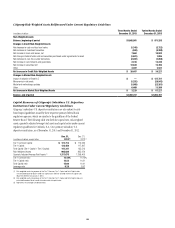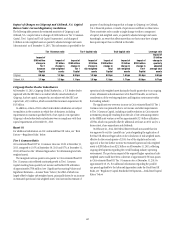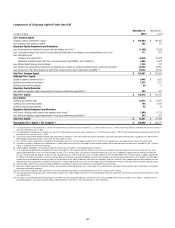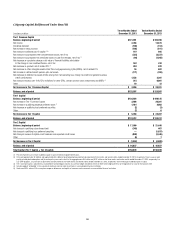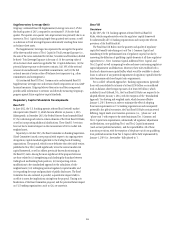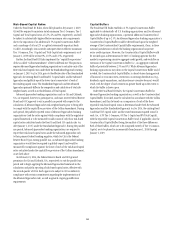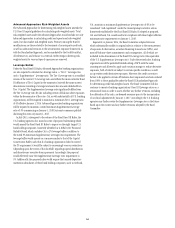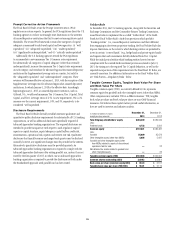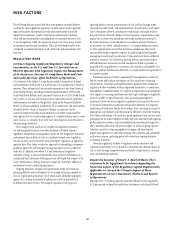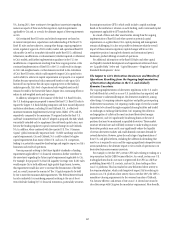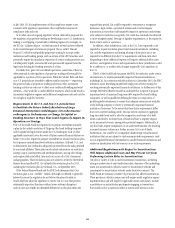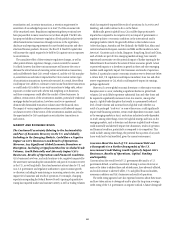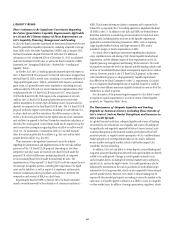Citibank 2013 Annual Report Download - page 73
Download and view the complete annual report
Please find page 73 of the 2013 Citibank annual report below. You can navigate through the pages in the report by either clicking on the pages listed below, or by using the keyword search tool below to find specific information within the annual report.
55
Prompt Corrective Action Framework
The Final Basel III Rules revise the Prompt Corrective Action (PCA)
regulations in certain respects. In general, the PCA regulations direct the U.S.
banking agencies to enforce increasingly strict limitations on the activities
of insured depository institutions that fail to meet certain regulatory capital
thresholds. The revised PCA framework contains five categories of capital
adequacy as measured by risk-based capital and leverage ratios: (i) “well
capitalized;” (ii) “adequately capitalized;” (iii) “undercapitalized;”
(iv) “significantly undercapitalized;” and (v) “critically undercapitalized.”
Additionally, the U.S. banking agencies revised the PCA regulations
to accommodate a new minimum Tier 1 Common ratio requirement
for substantially all categories of capital adequacy (other than critically
undercapitalized), increase the minimum Tier 1 Capital ratio requirement
at each category, and introduce for Advanced Approaches insured depository
institutions the Supplementary Leverage ratio as a metric, but only for
the “adequately capitalized” and “undercapitalized” categories. These
revisions will become effective on January 1, 2015, with the exception of the
Supplementary Leverage ratio for Advanced Approaches insured depository
institutions, for which January 1, 2018 is the effective date. Accordingly,
beginning January 1, 2015, an insured depository institution, such as
Citibank, N.A., would need minimum Tier 1 Common, Tier 1 Capital, Total
Capital, and Tier 1 Leverage ratios of 6.5% (a new requirement), 8% (a 2%
increase over the current requirement), 10%, and 5%, respectively, to be
considered “well capitalized.”
Disclosure Requirements
The Final Basel III Rules formally establish extensive qualitative and
quantitative public disclosure requirements for substantially all U.S. banking
organizations, as well as additional disclosures specifically required of
Advanced Approaches banking organizations. The required disclosures are
intended to provide transparency with respect to such regulatory capital
aspects as capital structure, capital adequacy, capital buffers, credit risk,
securitizations, operational risk, equities and interest rate risk. Qualitative
disclosures that typically remain unchanged each quarter may be disclosed
annually, however, any significant changes must be provided in the interim.
Alternatively, quantitative disclosures must be provided quarterly. An
Advanced Approaches banking organization is required to comply with the
Advanced Approaches disclosures after exiting parallel run, unless it has not
exited by the first quarter of 2015, in which case an Advanced Approaches
banking organization is required to provide the disclosures set forth under
the Standardized Approach until parallel run has been exited.
Volcker Rule
In December 2013, the U.S. banking agencies, along with the Securities and
Exchange Commission and the Commodity Futures Trading Commission,
issued final rules to implement the so-called “Volcker Rule” of the Dodd-
Frank Act (Final Volcker Rule). Aside from provisions which prohibit
“banking entities” (i.e., insured depository institutions and their affiliates)
from engaging in short-term proprietary trading, the Final Volcker Rule also
imposes limitations on the extent to which banking entities are permitted to
invest in certain “covered funds” (e.g., hedge funds and private equity funds)
and requires that such investments be fully deducted from Tier 1 Capital.
While the initial period within which banking entities have to become
compliant with the covered fund investment provisions extends to July 21,
2015, the timing as to the required Tier 1 Capital deduction, as well as the
expected incorporation of this requirement into the Final Basel III Rules, are
currently uncertain. For additional information on the Final Volcker Rule,
see “Risk Factors—Regulatory Risks” below.
Tangible Common Equity, Tangible Book Value Per Share
and Book Value Per Share
Tangible common equity (TCE), as currently defined by Citi, represents
common equity less goodwill and other intangible assets (other than MSRs).
Other companies may calculate TCE in a different manner. TCE, tangible
book value per share and book value per share are non-GAAP financial
measures. Citi believes these capital metrics provide useful information, as
they are used by investors and industry analysts.
In millions of dollars or shares,
except per share amounts
December 31,
2013
December 31,
2012
Total Citigroup stockholders’ equity $204,339 $189,049
Less:
Preferred stock 6,738 2,562
Common equity $197,601 $186,487
Less:
Goodwill 25,009 25,673
Other intangible assets (other than MSRs) 5,056 5,697
Goodwill and other intangible assets (other
than MSRs) related to assets of discontinued
operations held for sale —32
Net deferred tax assets related to goodwill and
other intangible assets —32
Tangible common equity (TCE) $167,536 $155,053
Common shares outstanding (CSO) 3,029.2 3,028.9
Book value per share (common equity/CSO) $ 65.23 $ 61.57
Tangible book value per share (TCE/CSO) $ 55.31 $ 51.19



